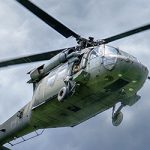How NATO Military Spending Measures Up Against Russia and China
Introduction
Seventy years ago, the North Atlantic Treaty Organization (NATO) was formed following the aftermath of World War II. Its members were committed to ensuring that peace would be maintained in Europe after years of devastating wars.
Since its inception, the alliance has grown from the 12 countries that first formed the alliance to 29 members; it staved off the Soviet Union during the Cold War; and it came together under Article 5 to support the US during the September 11 attacks.
But now the NATO alliance faces challenges on many fronts. Populist leaders have expressed doubts about NATO, calling the organization obsolete. President Trump has repeatedly stated that the US contributes significantly more to the alliance than many of its allies and has questioned the seriousness of members in upholding the shared responsibilities of the organization.
While some of these critiques reflect truth, NATO is far from obsolete. In order to address these critiques and ensure NATO’s viability over the next 70 years and beyond, the alliance needs to shift its focus from a rigid view based on contributions to a more flexible approach that works within the limits each member has to offer on NATO military spending. I
t’s equally important to understand how the alliance currently stands in relation to countries like Russia and China, what military platforms they are focused on procuring, and where improvements could be made.
NATO Military Spending: How much does NATO actually spend on defense?
During the 2014 Wales Summit, members of the alliance NATO military spending and agreed to increase defense spending to 2 percent of GDP by 2024 and allocate 20 percent of its budget toward acquiring new equipment.
As of 2019, only eight countries have reached that threshold:
- the US,
- Greece,
- UK,
- Estonia,
- Latvia,
- Lithuania,
- Poland, and
- Romania
There are several countries that are close to reaching the 2 percent goal, yet there are many more members that still fall far below it. Competing budget priorities, public opinion, and overall economic growth will ultimately determine the course of NATO military spending.
While many NATO countries were affected by the Eurozone crisis during the early part of the decade, defense spending has slowly rebounded. From 2013-2018, NATO countries increased defense spending by a total of 3 percent, though Russia and China also maintained the same growth.
Looking specifically at defense investment, funding for procurement and development increased 7.2 percent from 2013-2018. Of those NATO members (excluding the US), Lithuania, Bulgaria, and Romania have seen the biggest growth from 2013 to 2018 while defense investments from Greece, Denmark, and Turkey have declined.
Some scholars and defense analysts have questioned whether the best way to boost overall readiness is to insist on NATO military spending of 2 percent by 2024.
The goal of each member nation increasing defense spending to 2 percent of GDP by 2024 is unlikely to be achieved. Even if a country does allocate percent of its GDP towards defense, they still might not be allocating their defense spending towards NATO priorities.
The contributions of smaller countries, such as Montenegro or Luxembourg, toward the alliance will not be as significant as some of its larger neighbors, but this comes as no surprise as their combined armed forces contain under 5,000 personnel.
Montenegro’s accession into NATO was met with hostility from Russia, with some fearing that Montenegro’s membership could further push the alliance towards an all-out conflict with Russia.
The newly renamed North Macedonia is currently awaiting its accession into NATO but bears the same concerns as Montenegro’s membership. Russia’s influence in the Balkans runs deep, but NATO’s deepening relationship with Balkan countries could one day drag the alliance into a difficult predicament of defending the region.
Following Russia’s annexation of Crimea, this reality is not far off. Excluding the US, the NATO alliance allocated a combined $264 billion towards defense in 2018, almost four times Russia’s defense budget of $61 billion.
However, with China becoming more of a focus, Russia’s and China’s defense budgets combined outpace NATO Europe’s defense spending by almost $50 billion in 2018. Should China be perceived as more of a threat to NATO, then the pressure would grow to increase NATO military spending to meet 2 percent of GDP.
What NATO Members are Buying
(Note: Spending is based on data from Avascent Analytics GPS. Not all countries in the NATO alliance are covered in GPS. Dataset includes US defense spending)
Given the circumstances, the alliance should focus more on what members are procuring and how they can contribute in the face of limited resources. Understandably, countries with smaller defense budgets are unlikely to make significant contributions toward the procurement of new equipment and will likely supplement this with other support instead, such as contributing personnel to various NATO missions.
NATO Military Spending on Aircraft
A significant portion of NATO Military spending is on aircraft acquisitions and modifications. From 2014 to 2019, the UK, France, and Germany spent a combined $49 billion on aircraft platforms.
These acquisitions include the A400M military transport aircraft, Rafale fighters, the Eurofighter Typhoon, and the F-35. Estonia, Latvia, and Lithuania rank as the bottom three countries on aircraft spending for a combined $247 million.
Despite increasing their defense budgets to meet the 2 percent threshold, the Baltic countries do not possess the ability to acquire fighter jets and are unlikely to purchase any fighters going into the 2020s.
Instead, these countries have focused their acquisitions on transport aircraft, unmanned aerial systems (UAS), and rotorcraft capabilities.
The procurement of unmanned aerial systems in particular can certainly benefit NATO operations given the variety of missions UAS can perform and their relatively low cost compared to other platforms. Ultimately, this makes UAS a viable option for other countries in situations similar to the Baltic countries.
NATO Military Spending on Ground Forces
France and Germany maintain their place as the top spenders on ground vehicles, man-portable systems, and air-and-missile defense though Poland comes in as a solid third, bringing the combined total of the three countries to $19 billion.
Poland’s catapult into the top three is due to the Patriot air-and-missile defense (AMD) acquisition, though the once-bragged-about acquisition has now been de-prioritized with claims that Poland is not moving forward with purchasing the remaining six Patriot AMD systems.
Poland has been a vocal opponent of Russian activity in the region and one of the few countries that has increase defense spending to reach the 2 percent threshold. Though Poland aspires to increase defense spending to reach 2.5 percent by 2030, Avascent Analytics believes that various competing priorities within the state budget will ultimately hamper these ambitions.
Greece, Belgium, and Bulgaria rank as the bottom three countries for having spent the least on ground vehicles, man-portable systems, and air-and-missile defense systems over the past five years, spending a combined $431 million.
Greece has been more focused on aircraft acquisitions and modifications (such as the NH90, P-3 Orion service life extension, and F-16V upgrade) than the acquisition of ground force related equipment.
Furthermore, the main drivers that have shaped Greece’s military procurements over the last five years include the rise in migrants fleeing war torn countries and ongoing spats with Turkey.
Similarly, Belgium has also focused on upgrading its F-16 aircraft and acquiring the A400M while Bulgaria has modified its fleet of MiG-29s.
NATO Military Spending on Ships and Submarines
The UK is by far the largest spender on maritime acquisitions, with France and Canada following behind. Their combined maritime spending is $44 billion, with the UK representing slightly more than half the overall value.
The Royal Navy is acquiring eight Type 26 frigates from BAE Systems for anti-submarine warfare missions. Additionally, the Royal Navy is purchasing the Astute-class submarines and a Queen Elizabeth-class aircraft carrier. France is acquiring the Barracuda-class submarine, FREMM, and FTI frigates. Canada will also be acquiring the Type 26 under the Canadian Surface Combatant program, adding 15 ships to replace its Iroquois and Halifax-class vessels.
Lithuania, Latvia, and Croatia spent a combined $48 million on ships, ranking them as the lowest maritime platform spenders. Limited defense budgets have confined the countries to focusing on smaller maritime acquisitions, modifications to existing platforms, or even acquiring secondhand equipment.
While offshore patrol vessels do not necessarily fit into the various NATO missions, the acquisition of unmanned underwater vehicles will contribute to NATO’s new Maritime Unmanned Systems initiative.
Conclusion
Expecting each NATO member to push to reach 2 percent of GDP on defense is unrealistic, yet there should be pressure on NATO members who are not maintaining their current defense readiness or have shown a continually stagnant budget.
Despite the threatening headlines of Russia’s ongoing military activity, Russian defense budgets have declined significantly since 2014, from $84 billion to $61 billion in 2018, though this hardly makes them less of a threat.
This puts the alliance in a position where they can pool their military resources to combat Russian aggression across a variety of domains if they play to the strengths of each country. For countries that share a border with Russia, it’s clear that there is a push to increase defense spending given their proximity to Russia and the higher risk of a potential attack.
This has been the case with Poland, Romania, and the Baltic countries who have not only increased defense spending but are also actively modernizing their armed forces. By examining what countries are procuring, the NATO alliance can take a step back and look at where their strengths currently lie and what capabilities need to be further developed in order to maintain NATO’s readiness against any threat.





